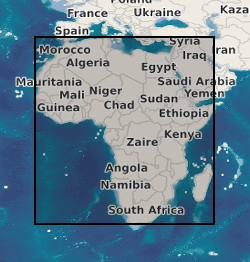Geothermal energy
Type of resources
Available actions
Topics
Keywords
Contact for the resource
Provided by
Years
Formats
Representation types
Update frequencies
Service types
Scale
Resolution
-
Geological model comprising artificial ground and superficial deposits in the city of Cardiff. Undifferentiated bedrock is included beneath the superficial deposits. This model provides a geological framework model and calculated surfaces for the superficial deposits for the city of Cardiff, principally Till, Glaciofluvial deposits, Alluvium and Tidal Flat Deposits.
-

A geographic information system (GIS) containing geo-data for the energy transition across continental Africa created by extracting data from open sources into a series of shapefiles and rasters containing information on culture, geology, geothermal and geophysical data. This data is stored in the World Geodetic System (WGS) 1984 Geographic Projection System.
-

This raster dataset shows the modelled P50 distribution of the theoretical potential 'heat-in-place' (HIP) across the northern and southern early Carboniferous limestone in Great Britain (PJ / km2), at a resolution of 2500 m x 2500 m. The HIP is calculated for resource temperatures greater than 50 degrees Celsius, which represents the minimum temperature required for direct use of heat from hot sedimentary aquifer resources. The HIP characterises the heat resource available in an aquifer according to the USGS definition described in e.g. Muffler and Cataldi (1978). Its calculation is part of the research published by D J.R. Jones, T. Randles, T. Kearsey, T.C. Pharaoh, A. Newell (2023). https://doi.org/10.1016/j.geothermics.2023.102649. Areas of high uncertainty are delineated in the published paper.
-

This dataset represents the thickness in metres of the Upper Devonian in the Midland Valley of Scotland (Stratheden Group and Kinnesswood Formation) over the extent of the model developed by Kearsey, T.I., Receveur, M. and Monaghan, A.A., 2024. Modelled hot sedimentary aquifer geothermal potential of Upper Devonian strata in the Midland Valley of Scotland. Uncertainties in the model are linked to the absence of boreholes penetrating both the top and the base of the Upper Devonian (except the Inch of Ferryton well) and poor seismic reflection data in the centre of the basin where it is thickest and deepest. The extent of the geological units is as shown on the published BGS geology maps, considering the re-interpretation of the Kinnesswood Formation as Devonian in age. The model is presented with high uncertainty.
-

This dataset represents the modelled thickness in metres of the Sherwood Sandstone Group (SSG) in the main Permo-Triassic Cheshire, Wessex, Worcester and East Yorkshire-Lincolnshire basins, considered for their hot sedimentary aquifer geothermal resource potential. This dataset is derived from Rollin, K. E., G. A. Kirby, and W. J. Rowley. Atlas of geothermal resources in Europe: UK revision. British Geological Survey technical report WK/95/7, Regional Geophysics Group, 1995: https://webapps.bgs.ac.uk/data/publications/publication.html?id=21735106 and the European Geothermal Atlas (https://op.europa.eu/publication-detail/-/publication/9003d463-03ed-4b0e-87e8-61325a2d4456).
-

This raster dataset provides the maximum temperature in the Upper Devonian formations in the Midland Valley of Scotland. The reservoir temperature is modelled over the extent of the base of the Kinneswood Formation and Stratheden Group, based on an updated geological model created by Kearsey, T.I., Receveur, M. and Monaghan, A.A., 2024. Modelled hot sedimentary aquifer geothermal potential of Upper Devonian strata in the Midland Valley of Scotland. The model is presented with high uncertainty.
-

This vector contour dataset represents the temperature distribution in the Carboniferous Fell Sandstone Formation (Mid Border Group), at the mid reservoir depth, in the Northumberland-Solway Basin.
-

This raster dataset represents the depth in metres to the top of the Upper Devonian in the Midland Valley of Scotland (top Kinnesswood Formation) over the extent of the model developed by Kearsey, T.I., Receveur, M. and Monaghan, A.A., 2024. Modelled hot sedimentary aquifer geothermal potential of Upper Devonian strata in the Midland Valley of Scotland. Uncertainties in the model are linked to the absence of boreholes penetrating both the top and the base of the Upper Devonian (except the Inch of Ferryton well) and poor seismic reflection data in the centre of the basin where it is thickest and deepest. The extent of the geological units is as shown on the published BGS geology maps, considering the re-interpretation of the Kinnesswood Formation as Devonian in age. The model is presented with high uncertainty.
-

This vector contour dataset represents the distribution of the estimated, theoretical potential 'geothermal resources' (in GJ/m2 or PJ/km2) for the Carboniferous Fell Sandstone Formation (Mid Border Group) in the Northumberland-Solway Basin. This grid is the heat-in-place, and represents the amount of heat contained in the productive parts of the identified aquifers (i.e. those with sufficient porosity and permeability to be considered hot sedimentary aquifer resources).
-

This raster dataset represents the depth in metres to the top of the early Carboniferous limestone (ECL) over the Northern and Southern Provinces in Great Britain. The raster grid is provided at a 2500 m resolution. The layer can be used to identify prospective geothermal heat resources, such as areas with deep burial depths beneath thick Permian-Mesozoic sequences, as in the Cheshire Basin, and the flanks of the East Irish Sea and Southern North Sea basins; or beneath thick later Carboniferous strata, as in the Stoke-on-Trent area.
 NERC Data Catalogue Service
NERC Data Catalogue Service